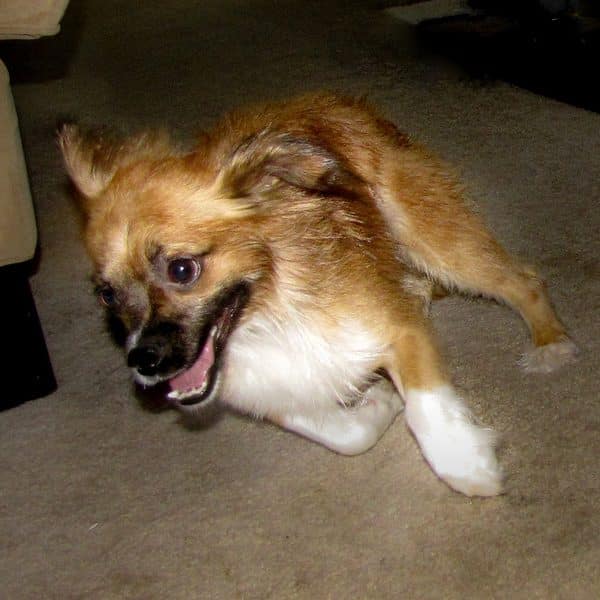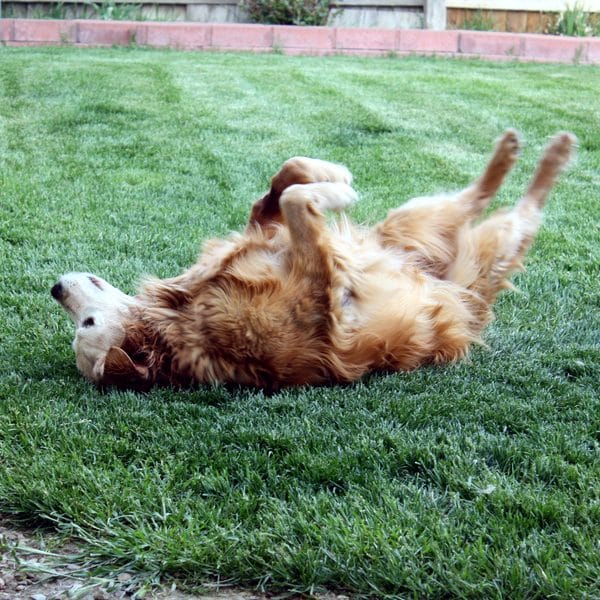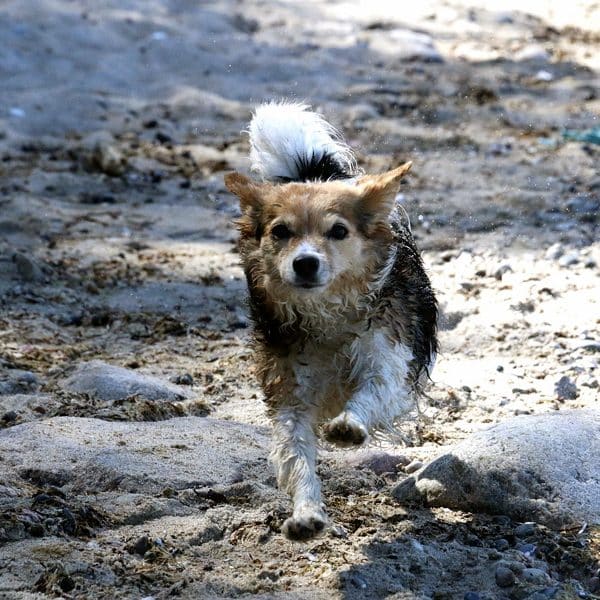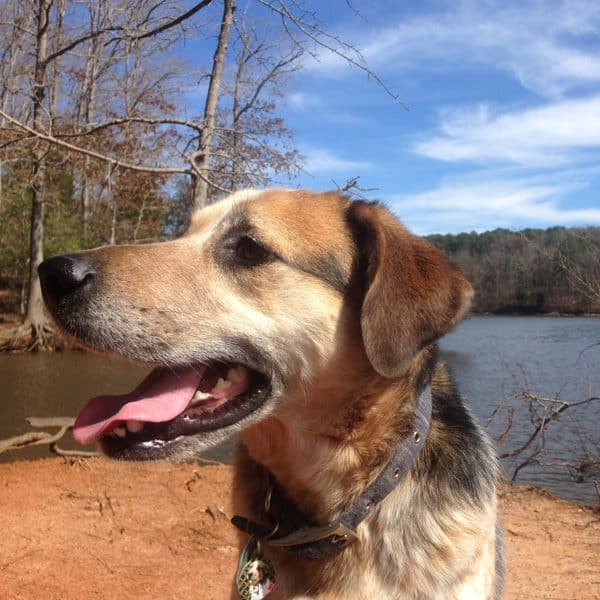My dog, Baby, is a Bluetick Coonhound mix, and at well over 3 years old, she seems to have lost none of her puppy energy. Most days, I’ll take her for a 3-mile hike so that both of us can get some exercise. Well, I say “hike.” Usually, I’m either encouraging her to move forward, since she stops every 5 feet to investigate an interesting scent, or bracing myself to prevent her from giving chase to a nearby squirrel. By the time we get home, I’m worn out. This is usually when she gets the zoomies or starts frapping.

Some dogs don’t understand “No running indoors!” (Photo by Christina Spicuzza on Flickr)
Wait, I can hear you saying, frapping? Zoomies? The lingo sounds strange. Zoomies evokes illicit narcotics from comic books or science fiction movies. Frapping makes it sound like my dog has started performing French hip-hop. For a more accurate notion, let me conclude my story a different way. It’s after 3 miles of uneven terrain with a powerful and physical dog that Baby decides she wants to wrestle, play tug of war or just race repeatedly around the backyard. Does that sound more familiar and relatable?
My dog has a case of the zoomies!
The more sophisticated our understanding of dog behaviors become, the more that homespun colloquialisms pass into obscurity. Have you ever seen the British television series All Creatures Great and Small, based on the works of James Herriot? If so, you’ll remember Mrs. Pumphrey’s Pekingese, Tricky-Woo, frequently came down with “Flop Bott.” These days, vets call the condition “impacted anal glands;” it may be less colorful, but it has the advantage of being far more accurate.
In Baby’s case, and probably that of millions of other dogs, a case of the zoomies has also had some of its charm stripped away with the march of progress. Canine behavior specialists and trainers have come to give these seemingly unaccountable bursts of dog energy a scientific-sounding name: frenetic random activity periods, or FRAP episodes. Unlike Tricky-Woo’s recurrent anal sac problem, though, dog zoomies are not a medical issue, but a behavioral one.
What is frapping?
The pseudo-technical term “Frenetic Random Activity Period” doesn’t appear much in the literature of dog behaviors until after 2000. In the last few years, it’s become ubiquitous; so much so, that now we appear to have come full circle in our nomenclature. The acronym FRAP has given way to “frap” and “frapping,” both of which are more difficult to parse than “zoomies.” Enough etymology! What does it all mean? Is it something that dog owners should worry about? Are there practical solutions?

Running and rolling are both expressions of frenetic activity. (Photo by Robert Tadlock on Flickr)
The most typical examples of frapping will be immediately recognizable to a large population of dog owners. Have you ever heard yourself exasperatedly utter any of the following questions?
- Why do dogs suddenly run around the house like crazy?
- Why do dogs go crazy after a bath?
- Why does my dog go crazy after a walk?
Actually, if you’ve ever attributed the word “crazy” to some pattern of canine physical activity — running, racing, jumping, rolling around or even moments of playful aggression — then you’ve got a frapping dog or puppy. Two of the three activities in our list, though, give the lie to the “random” in FRAP. Whether it’s a mischievous puppy or a sedentary adult dog, there’s very little that’s random about the zoomies. Let’s look at each scenario in turn.
Why do dogs get zoomies in the house?
Unless your dog is an inveterate couch potato, dogs are kinetic creatures by their nature. They need to move and despise all manner of restrictions on their mobility. Dog owners can train them to accept many circumstances that inhibit their freedom of movement, whether it’s a space as large as a house or as small as a crate. A dog will wait in your living room until you return from work or school, but they’d almost always be outdoors, running here and there. Dogs need to move.
A dog whose life and activity are limited by the walls of a house, no matter how spacious, eventually has to turn their potential energy into kinetic energy. Call it the zoomies or frapping; either way, a dog cannot sit still forever. This can be problematic if you have delicate or fragile objects imbued with sentimental value stationed around your home. Dog owners can get upset with a dog who’s accidentally broken the tea pot inherited from Grandma, or your carefully curated collection of Precious Moments figurines, but this is frequently a consequence of leaving a dog indoors for hours at a time.
Why do dogs run or roll around after bathing?
The answers may not be exact, but there’s really nothing “random” to the frenetic bursts of energy your dog displays after a bath. Human beings are obviously different from dogs in any number of ways, but the relevant one to point out here is our hygiene protocols. From childhood, we’re told to take our bath or shower before we go to bed, when we get up in the morning, ad infinitum. Dogs, on the other hand, we’re told we must bathe once a month, if that.

Many dogs can be counted on to frap after baths. (Photo via Pixabay)
The simple fact of the matter is, that, like physical confinement, dogs by nature are not used to being thoroughly cleaned and scrubbed, whether it’s with soaps and shampoos during, or with towels afterward. Unless you have a relatively hairless dog, the process of being drenched and dried is unusual and uncomfortable for most dogs. Over at The Dodo, vet Dr. Ladan Mohammad-Zadeh speculates that the weight of water, the time it takes to dry off and feel normal again, and even the powerful artificial scent of cleaning products, might cause a dog to become restless, if not hyperactive. This energy is burned off by running, shaking and even rolling on the ground.
Why does my dog go crazy after a walk?
We started this look at zoomies and frapping in dogs with a story about my own dog. After 3 years with her, I’ve reached my own conclusion about her bursts of energy. They don’t happen every time we go for a walk, but Baby’s episodes do occur most frequently when we get home after exercise, so that at least is predictable. I’ve written previously for Dogster about walking with your dog as exercise for both dog and owner.
It’s a simple fact the average dog can run faster than the average dog owner. Any walk Baby and I take together, no matter how rigorous or exhausting for me, is never going to fully satisfy Baby’s need to move. Zoomies are not only expressed as bursts of energy, I find, but also as refusal to move in protest. She knows our typical hiking routes very well by this point. If Baby feels she has not had her personal needs met when we are leaving the park, she will either plant her feet firmly on the ground or start rolling around on the ground, like some do in response to baths.
Does your dog go wild sometimes?
Learning to anticipate and deal with our dog’s individual behaviors is a crucial part of dog ownership. You might be amused when your dog starts running around the living room at random moments. I sometimes get frustrated or cross when Baby wants to wrestle after a long hike. If you’re exercising your dog regularly, and they still get a case of the zoomies, it’s not your fault and it’s not your dog’s.

Baby, in the calm between cases of the zoomies. (Photo by Melvin Peña)
Even the best trained dogs will experience frenetic random activity periods now and then. If you have standard practices for calming or soothing your dog that are ineffective during these episodes, making sure they have room to let it out and regain composure on their own is by no means a bad thing.
The post Is Your Dog Going Crazy? They May Have a Case of the Zoomies! appeared first on Dogster.
No comments:
Post a Comment